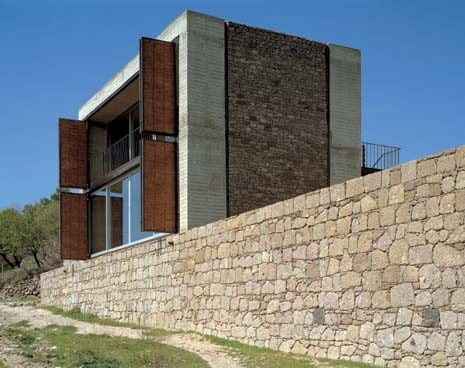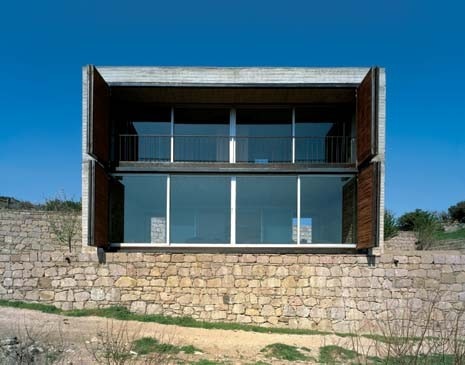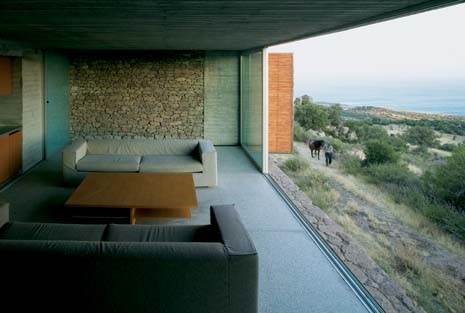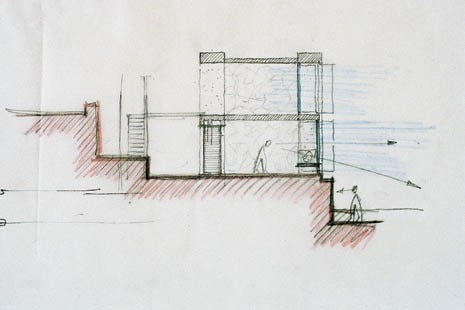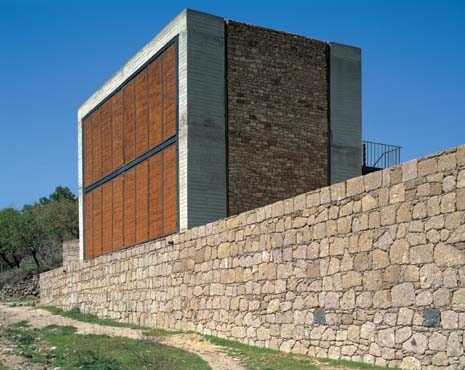Both strange and familiar
by Tansel Korkmaz
We owe it to modernity that the relationship between the “inside” and “outside” of home is defined as one of such irresolvable tension. Modernity irreparably shattered the traditional co-existence of inner and outer worlds described as a harmonious, “organic” whole. The home became a commodity circulating in the marketplace. But home is that which completes, unifies and signifies mutual belongingness and affiliation. Modernity, ruled by transience and movement, rejects affiliation. The home is no longer a place from which one can be connected to the world: modern man is a wanderer, the home a commodity.
In the modern world a home is just a house, the house of anyone who can afford to own it and therefore no one’s home. The modern house has no memory. The impossibility of home both promises freedom and signifies deprivation. Efforts to compensate for that impoverishment are usually in vain. B2 is home in the absolute sense. It does not try to be “a nostalgic microcosmos”, to appear as “home, sweet home” to mask deprivation with excess and artificiality. It is what it is. It can remain silent and it can make room for emptiness. The plan of the design is legible in the extreme.
The service spaces of the house are squeezed into a “narrow band” and residential space into an almost completely emptied “broad band”—a living unit contained on the ground floor with two bedroom units on the top floor. The broad band looks out through the completely transparent front facade over the tremendous emptiness stretching out before it, while the rear facade turns its back on a lyrical village view; the narrow band is like a barrier detaching the broad band from the village. The blind-sided facades frame the view.
The broad band, insulated on three sides, is dominated by the front view of the emptiness which becomes a valley punctuated by the sea. Here a person feels he is thrown out into infinity and is fascinated by the uncanny sense of being on the edge of the world. It is as if everything ordinary had become unimportant, as if, on that edge, the world were suspended in timelessness. B2 does not try to respond to the huge emptiness outside with facile compensation or reactionary over-articulation of the interior. It echoes the emptiness calmly within its broad band. The natural emptiness of the place is met with one designed: it is an act of mimesis in itself, or “imitation” as defined by Quatrémere de Quincy.
B2 is home in the most absolute sense, a place from which one cannot retreat further. Reminiscent of the ever-absent primordial beginning, it dwells on the long-forgotten traces of a never-existent origin as an archetypal artefact par excellence. “Another of the prisms in the village” is how Han Tümertekin describes B2, and this phrase in itself provides clues to the intervention performed there. To call a home in a village a “prism” tells us it will be founded on an abstraction. “Another of the prisms in the village” is an intervention that aims to establish both continuity and a break, a rupture. It seeks continuity; it listens to the call of place, of what has been accumulated there. But continuity harbours within itself spontaneity and compromise. In rejecting spontaneity and compromise, B2 abandons continuity.
It would rather pursue the ideal. This is a moment of decision: to establish an ideal unity within itself. It is in this sense that B2 is both familiar and strange: familiar without trying to “seem like”, strange without seeking to be different. The site has been terraced to form a platform for the prism, a platform which provides it with an ideal ground and separates it from the pre-existing context. B2’s manicured grass turf is in sharp contrast to the randomly employed village grounds. The stone building material used is the same as for the other houses, but in this case it is used to fill in girders of reinforced concrete. The care taken with the masonry creates a texture different from that of the village houses. Straw matting, another familiar material, is used for shutters which fill aluminium frames.
The afternoon sun filters through them to fill the house while the sea view remains like a faded memory, everything takes on a cloudlike aspect and the space is read completely differently. Manufactured materials (concrete, aluminium) are used to sharpen the contours of textures formed by local, natural materials (stone, straw matting). From the inside these are no longer read as stone walls, concrete girders, straw-mat shutters and glass surfaces but differently textured, alternating planes floating through the interior space. They make up the only ornament of the space, none other is needed.
The main feature giving B2 its orientation is the panoramic view—nature as spectacle. The house is situated precisely at the place where the village ends or where the house draws the borderline of the village. From this position it defines two different views: the front view, framed by the transparent facade, looking out over the valley at the sea, and the rear view of the village seen from the deck/terrace outside the bedrooms. Both are views defined by the house’s position and overall plan: B2 brings out the pre-existent potential of the “place”, and the potential of the “place” defines the position and plan of the house. The transparency of the front facade with its blind sides and rear focuses attention on the valley seen from the front and the sea beyond it, an emptiness drawing everything towards it like a vacuum.
The mutual relationship formed between home and “place” transforms both perspectives, and B2, defined with layered anonymity as “another of the prisms in the village”, remains unique within the context. And so, what differentiates this prism from the others in the village is not a longing to sign one’s name. On the contrary, the subject is withdrawn and B2 becomes different, unique to the point where it brings out the internal logic of the object, the potential of “place”. It is within this framework that architecture excites us, affecting us not by a fruitless search for the new, but by perfecting the familiar and bringing out its as yet undiscovered potential. B2’s secret is very simple but also very architectural: perfect mediation between design, desire of place, and the logic of construction.
Winner of the domestic category of the Aga Khan Prize, Han Tümertekin’s retreat for two brothers mediates between modern influences and local vernacular. Photography by Cemal Emden. Edited by Joseph Grima
Both strange and familiar
by Tansel Korkmaz
We owe it to modernity that the relationship between the “inside” and “outside” of home is defined as one of such irresolvable tension. Modernity irreparably shattered the traditional co-existence of inner and outer worlds described as a harmonious, “organic” whole. The home became a commodity circulating in the marketplace. But home is that which completes, unifies and signifies mutual belongingness and affiliation. Modernity, ruled by transience and movement, rejects affiliation. The home is no longer a place from which one can be connected to the world: modern man is a wanderer, the home a commodity.
In the modern world a home is just a house, the house of anyone who can afford to own it and therefore no one’s home. The modern house has no memory. The impossibility of home both promises freedom and signifies deprivation. Efforts to compensate for that impoverishment are usually in vain. B2 is home in the absolute sense. It does not try to be “a nostalgic microcosmos”, to appear as “home, sweet home” to mask deprivation with excess and artificiality. It is what it is. It can remain silent and it can make room for emptiness. The plan of the design is legible in the extreme.
The service spaces of the house are squeezed into a “narrow band” and residential space into an almost completely emptied “broad band”—a living unit contained on the ground floor with two bedroom units on the top floor. The broad band looks out through the completely transparent front facade over the tremendous emptiness stretching out before it, while the rear facade turns its back on a lyrical village view; the narrow band is like a barrier detaching the broad band from the village. The blind-sided facades frame the view.
The broad band, insulated on three sides, is dominated by the front view of the emptiness which becomes a valley punctuated by the sea. Here a person feels he is thrown out into infinity and is fascinated by the uncanny sense of being on the edge of the world. It is as if everything ordinary had become unimportant, as if, on that edge, the world were suspended in timelessness. B2 does not try to respond to the huge emptiness outside with facile compensation or reactionary over-articulation of the interior. It echoes the emptiness calmly within its broad band. The natural emptiness of the place is met with one designed: it is an act of mimesis in itself, or “imitation” as defined by Quatrémere de Quincy.
B2 is home in the most absolute sense, a place from which one cannot retreat further. Reminiscent of the ever-absent primordial beginning, it dwells on the long-forgotten traces of a never-existent origin as an archetypal artefact par excellence. “Another of the prisms in the village” is how Han Tümertekin describes B2, and this phrase in itself provides clues to the intervention performed there. To call a home in a village a “prism” tells us it will be founded on an abstraction. “Another of the prisms in the village” is an intervention that aims to establish both continuity and a break, a rupture. It seeks continuity; it listens to the call of place, of what has been accumulated there. But continuity harbours within itself spontaneity and compromise. In rejecting spontaneity and compromise, B2 abandons continuity.
It would rather pursue the ideal. This is a moment of decision: to establish an ideal unity within itself. It is in this sense that B2 is both familiar and strange: familiar without trying to “seem like”, strange without seeking to be different. The site has been terraced to form a platform for the prism, a platform which provides it with an ideal ground and separates it from the pre-existing context. B2’s manicured grass turf is in sharp contrast to the randomly employed village grounds. The stone building material used is the same as for the other houses, but in this case it is used to fill in girders of reinforced concrete. The care taken with the masonry creates a texture different from that of the village houses. Straw matting, another familiar material, is used for shutters which fill aluminium frames.
The afternoon sun filters through them to fill the house while the sea view remains like a faded memory, everything takes on a cloudlike aspect and the space is read completely differently. Manufactured materials (concrete, aluminium) are used to sharpen the contours of textures formed by local, natural materials (stone, straw matting). From the inside these are no longer read as stone walls, concrete girders, straw-mat shutters and glass surfaces but differently textured, alternating planes floating through the interior space. They make up the only ornament of the space, none other is needed.
The main feature giving B2 its orientation is the panoramic view—nature as spectacle. The house is situated precisely at the place where the village ends or where the house draws the borderline of the village. From this position it defines two different views: the front view, framed by the transparent facade, looking out over the valley at the sea, and the rear view of the village seen from the deck/terrace outside the bedrooms. Both are views defined by the house’s position and overall plan: B2 brings out the pre-existent potential of the “place”, and the potential of the “place” defines the position and plan of the house. The transparency of the front facade with its blind sides and rear focuses attention on the valley seen from the front and the sea beyond it, an emptiness drawing everything towards it like a vacuum.
The mutual relationship formed between home and “place” transforms both perspectives, and B2, defined with layered anonymity as “another of the prisms in the village”, remains unique within the context. And so, what differentiates this prism from the others in the village is not a longing to sign one’s name. On the contrary, the subject is withdrawn and B2 becomes different, unique to the point where it brings out the internal logic of the object, the potential of “place”. It is within this framework that architecture excites us, affecting us not by a fruitless search for the new, but by perfecting the familiar and bringing out its as yet undiscovered potential. B2’s secret is very simple but also very architectural: perfect mediation between design, desire of place, and the logic of construction.
Tansel Korkmaz is a professor at Istanbul Bilgi University. This article is the revised and edited version of one published in XXI Mimarlik Kültürü Dergisi, n. 9 (July-August 2001).
